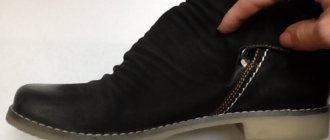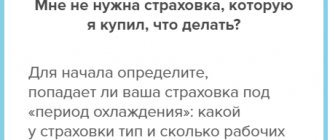How to choose the right shoe size
- Consider the fullness of your feet when purchasing shoes. Tight shoes impair blood supply, the foot may become deformed, and muscle function may deteriorate. Don't expect shoes to be easy to break in. This process is not quick, you will get quite a few calluses while this happens. With corns, even in shoes that fit properly, it will be uncomfortable. You should not buy shoes that are too narrow, even if they are of normal length. Find a model that will fit both in size and fullness.
- While walking, the foot changes in size. In this regard, the internal volume of the shoe should be slightly larger than the foot. How to choose the right shoes in a store? You need to stand, stomp and walk around in your shoes, listening to your feelings. The toes should be free and move easily. There should be some free space between the big toe and the inside of the toe of the shoe. Otherwise, the finger will be bent.
- Choose your shoes wisely. The model must fit your feet, otherwise calluses and chafing will begin to appear on your feet. If the sores occur several times in the same place, chronic skin damage is possible, which is difficult to heal.
- In the morning the foot size is slightly smaller than in the evening. At a later time, the foot becomes somewhat larger. It is recommended to purchase shoes at the time of day at which they will be worn. Buy evening shoes in the evening, and casual shoes around noon.
- It is important to choose the right shoes - they must fit in size. Naturally, shoes should not be small. If you wear tight shoes for a long time, your foot will become deformed. Over time, troubles will appear: a Hallux Valgus bone will form, and the toes may become like hammers. If the feet are constantly compressed in shoes, blood circulation in the legs is impaired.
- Don't buy shoes that are too roomy. When wearing such shoes, the appearance of calluses and chafing is inevitable. When shoes or boots are too small, it's even worse. Calluses will remain, and in addition the fingers will become bent, blood circulation will be impaired and ingrown nails will appear.
- You need to choose the right shoes. You should not sit while trying on the product. As you walk, your feet become longer. You should walk around a little in the pair you like.
- For some people, the size of the right and left feet may differ. What does this mean? For example, a model you like fits one leg perfectly, but the other feels uncomfortable in it. It is advisable to choose the right shoes according to the size. You need to focus on the leg that has the larger size. You may need to try on several styles to find the right pair that feels comfortable on both feet.
- Choose your shoes wisely. When trying on shoes, put both shoes on and walk around the fitting room. In a model that fits properly, you should feel that your toes are just touching the inside of the sock, but not pressing into it. If you run your hand over the outside of the shoes, your palm should not feel the toes protruding like tubercles.
Oddly enough, it is easier to find shoes for full feet than for narrow feet. If the product is too wide, insert a bulky insole. You can make it yourself by cutting it out of cardboard and pasting it with thick material. True, you will have to change the homemade insole in a few months.
Winter period for shoes from what date
The Law “On the Protection of Consumer Rights (Clause 2, Article 19) and the Rules for the sale of certain types of food and non-food products establish that for seasonal goods (clothing, shoes and other products), the deadline for filing claims is calculated from the beginning of the corresponding season. However, it is necessary to distinguish between seasonal and non-seasonal shoes.
If out-of-season shoes are purchased, the warranty is calculated from the date of their sale/purchase.
For seasonal shoes of domestic and imported production, purchased before the onset of the season, the guarantee is given from the beginning of the corresponding seasons, the onset of which is determined accordingly by the constituent entities of the Russian Federation, based on the climatic conditions of the location of the consumers.
Or your son’s sole has come off in the toe area. But take a closer look at your child’s gait. Perhaps the entire toe part of such shoes will be mechanically damaged.
Important
Please also remember that replacement parts, fittings and heels are not covered by the warranty. If your laces are torn, the heel has worn out, or the zipper keychain has fallen off, this is not a defect.
If a disagreement arises between the seller and the buyer, the seller has the right to check the quality of the goods. This is not an examination, and even if the defect turns out to be non-manufacturing, you will not have to pay for it.
If a defect is discovered during the warranty period, the Seller is obliged to conduct an examination. However, if an independent examination determines the defect to be non-manufacturing, you will have to reimburse the Seller for the cost of the examination.
If you discover a defect after the warranty has expired, contact the Seller in any case.
Seasonality of shoes
General technical conditions” established a minimum warranty period of thirty days. How many? So, when paying for your purchase, you should hear from the seller or cashier the warranty period for your shoes. In most shoe stores, this is part of the customer service standard.
If this period was not indicated to you, it should be indicated on the box with the new item. We have already figured out that no seller has the right to establish a warranty period of less than 30 days. But more is always welcome.
Establishing a warranty period greater than 30 days depends on many factors that sellers and manufacturers take into account.
What time does the deadline for seasonal shoes in Kemerovo begin?
In cases where a product with a seasonal purpose was purchased during the season, and subsequently defects were discovered in it that were not specified by the seller, the buyer has the right to make a claim regarding the sold product within the established warranty period or six months if the warranty period is not established , from the moment of purchase of the goods.
Warranty periods for seasonal shoes begin from the beginning of the corresponding season (winter begins on November 1, spring - April 1, summer - June 1, autumn - September 1). So, if you bought winter boots in the summer, then their warranty period begins in November (provided that the receipt has been saved).
And if you purchased autumn boots in August and immediately put them on, but after a couple of days the soles came off, the store will most likely refuse to return your money because you started wearing shoes earlier than the fall season.
How long is the warranty period for shoes?
If we consider, for example, the climatic conditions of the European part of Russia, in particular Moscow and the Moscow region, then the seasons are determined by the following calendar periods: winter - from November 1 to March 1; spring – from March 1 to May 1; summer – from May 1 to September 1; autumn – from September 1 to November 15. That is, if, for example, you are a resident of Moscow and bought winter shoes in the summer, it is quite logical that you will wear them no earlier than November.
Pitfalls of the warranty period The warranty period is calculated from the date of transfer of the goods to the consumer, unless otherwise provided by the contract. If the day of delivery cannot be determined, these periods are calculated from the date of manufacture of the goods. So, what pitfalls may arise in making these claims: There is no warranty period for the product. The fact is that the manufacturer has the right, but is not obligated, to establish a warranty period for the product.
Warranty period for winter shoes
If the buyer has suspicions that the store is underestimating the warranty period, he can contact the manufacturer and clarify information on the warranty period. I have identified the shortcomings of seasonal shoes in your store. I purchased summer shoes article number (specify article number) for the price of rub. The shoes have a warranty period of 30 days. I started wearing them at the beginning of June and 2 weeks after wearing them the platform came off and cracked in half.
When contacting the store on June 18 this year. with a demand to return money for a product of inadequate quality, I was verbally refused a refund due to the expiration of the warranty period. P . 2 tbsp.
19 of the Law for seasonal goods (shoes, clothing and others), the warranty periods are calculated from the onset of the corresponding season, the onset of which is determined accordingly by the constituent entities of the Russian Federation based on the climatic conditions of the location of consumers.
Attention
These standards must be observed by the manufacturer based on specific GOST:
- Everyday – 30-80 days – GOST 26167:2009.
- Sports – 60 days – GOST 2063-92.
- Model – 60-90 days – GOST 19116.
- Children's - 30 days - GOST 26165.
- Home and road – 30-35 days – GOST 1135-88.
How long is the warranty for winter leather shoes? In this case, the same principles apply as for the usual one, since the law does not have a clear distribution of such goods. Such items are subject to exchange and return with payment of the money spent.
Source: https://dtpstory.ru/zimnij-period-na-obuv-s-kakogo-chisla/
How to choose the right shoes for fullness
Many people confuse fullness with the width of shoes. The fullness of a shoe can be determined in the tufts - the volume of the foot at its widest point. The linea fasciculata extends from the bone of the big toe and little toe to the back of the foot. Based on this size and the height of the foot, the fullness of the shoe is calculated. International classification of fatness: E – I. The most common values are F, G, H, F – slender legs, F1/2, G – average fatness, G1/2, H and so on – full leg.
Even young children have different foot fullness.
If you choose the right shoe size, the product will fit snugly on your foot and not be too tight. If the fullness is greater than necessary, the product dangles - the foot slides towards the toe, and the heel slips out of the heel. If the fullness is small, the shoes wear down easily. In addition, being in a compressed state for a long time is not very good for your finger joints.
It is important to choose the right shoes according to the fullness of your feet. Inadequate footwear leads to disastrous consequences. Too much fullness causes the foot to ride inside. The fingers, helping the foot to hold on, become overextended, and this is fraught with spasms. Excessively small fullness leads to constant compression of the toes, as a result of which the foot is deformed. After some time, chronic pain occurs.
How to choose the right men's shoes
Men take their choice of new boots seriously. You need to look for shoes that you don't just like. It is desirable that it be comfortable. High-quality shoes “sit” on the foot. In tight and heavy boots, your feet will get tired. And if the material does not allow air to pass through well, then walking will turn into torture. An unpleasant odor, common to many men, may also appear.
How to choose the right men's shoes?
- Each shoe has its own purpose
It is necessary to purchase shoes that are suitable for the season, as well as for the specific occasion. This is an obvious thing. Some men believe that having one or two pairs of shoes for any occasion is enough. This is a misconception. Even sneakers are different. There are purely sports models, and some products are suitable only for young people. It is recommended to have several pairs of different shoes to use for one occasion or another.
- Comfortable insoles
High-quality shoes have removable insoles. What causes an unpleasant odor? Most often this is typical for shoes that are not dry. If the insoles can be removed and dried, this is a plus. It is desirable that they are made from natural material. The most common is cotton.
- Soft sole
You should choose the right shoes. Don’t forget to test models for sole flexibility. Otherwise, how can you understand whether the shoes will be comfortable or not? If the sole is hard and does not bend well, you should not purchase such a product; your legs will constantly get tired. An easy gait will be ensured by models whose soles easily bend in the part located next to the toes. This area is where the foot naturally bends.
- Products with lacing
Where to buy comfortable shoes in size
If you are interested in the latest men's and women's shoes from Italy, take a look at our Vivendi store. Here you will find models from more than forty Italian designers. The presented assortment will allow you to get acquainted with the latest trends in both women's and men's shoe fashion.
Our advantages:
- DELIVERY IS FREE! Delivery to any region of Russia is free upon purchase of more than 20,000 rubles.
- PRICES ARE BELOW MARKET AVERAGE. Thanks to direct deliveries from manufacturers, we offer shoes with a minimal margin. In addition, the store regularly holds sales and has a system of discounts.
- QUALITY AND AUTHENTICITY GUARANTEED. We deliver shoes from Italy ourselves, and therefore we are 100% confident in their quality.
- CHAIN STORE IN MOSCOW. If you need to evaluate the look and quality of shoes with your own eyes, visit one of our stores.
- CONVENIENCE OF PAYMENT. Cash and non-cash payments, bank cards and electronic currency - you choose the most convenient payment method. A reliable system for protecting user data makes the purchase safe.
- DELIVERY IN SEVERAL SIZES FOR TRYING ON. Order several sizes and models for delivery at once and choose the most convenient one.
Go to catalog
The onset of the winter season for shoes Moscow
These standards must be observed by the manufacturer based on specific GOST:
- Everyday – 30-80 days – GOST 26167:2009.
- Sports – 60 days – GOST 2063-92.
- Model – 60-90 days – GOST 19116.
- Children's - 30 days - GOST 26165.
- Home and road – 30-35 days – GOST 1135-88.
How long is the warranty for winter leather shoes? In this case, the same principles apply as for the usual one, since the law does not have a clear distribution of such goods. Such items are subject to exchange and return with payment of the money spent. Seasons The warranty period for winter shoes also applies if they were purchased at a seasonal sale. Moreover, it does not begin from the date of purchase, but with the arrival of the wearing season. This period may vary in regions depending on the climate.









